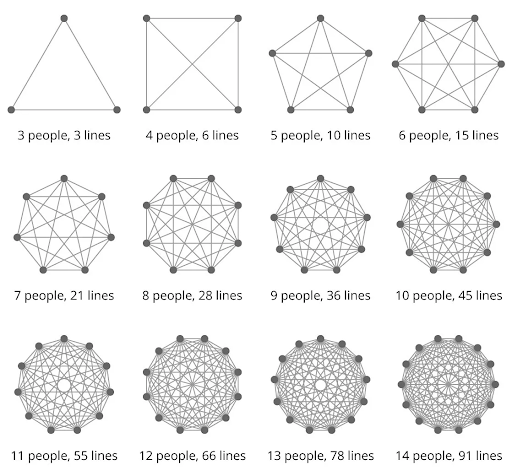Agile coaching
The secret to building great stuff? Talk little but often.
02 February 2023 • 5 min read

If you find yourself reading this a bit tired, unmotivated and distant from your product team, don’t panic, you're not alone. The feeling of being engaged and motivated waxes and wanes, so we've got some tips to get your team's communication back on track. Talking little and often to team members, stakeholders and customers can lead to better outcomes.
Communication as weak as hotspot wifi can quickly isolate team members, who become disconnected from the purpose of the project, their roles, and the value of their contributions. However, when done well, communication creates a common pool of ideas and strengthens the feeling of togetherness. It translates thoughts into action.
We recognise its importance to succeed yet we often find ourselves hiding our voice or reducing our communication channels.
Working in a team makes us happier and more productive
Research tells us that when we work together as part of a team people are happier and more productive. However, without the ability to communicate well, we get trapped in an almost suffocating bubble engulfing the entire team. It can zap motivation and energy.
Here are some stats that illustrate the challenges and issues:
- 86% of employees and executives cite the lack of effective collaboration and communication as the main causes for workplace problems.
- 51.7% of workers felt uncomfortable discussing their mental wellbeing with colleagues.
- Teams who communicate effectively may increase their productivity by as much as 25%.
- Miscommunication costs companies with 100 employees an average of $420,000 per year.
Software development teams often consist of around 10 people all working together to achieve the same goal. 10 people results in 45 different lines of communication, so we know it’s not easy.

Hold a session to zoom out
Sometimes we need to zoom out and identify where communication and collaboration fails between multiple teams. Quick fixes here can reap huge benefits. For example, knowing what another team is working on could provide valuable insights to solve your own team's problems. Sometimes there’s a communication breakdown between businesses and their customers. Tumbling along year on year believing your customers' needs remain static and competitors won’t change is naive and can ultimately lead to the extinction of your business.
Read next: The importance of team health-checks at work
Agile principles can guide how we should communicate to each other
The most popular methodology for software development is Agile. Scrum is an Agile framework that consists of a carefully crafted team, including a product owner, a scrum master and multiple developers. Agile requires the ability for teams and organisations to make decisions quickly and flexibly. The framework adopts for principles in its manifesto:
| Individuals and interactions | over | People and tools |
| Working software | over | Comprehensive documentation |
| Customer collaboration | over | Contract negotiation |
| Responding to change | over | Following a plan |
Following these four principles directly links to how we communicate to each other. For example: working software over documentation is about avoiding time consuming processes like finding, storing, sharing & updating lengthy documentation and about delivering the same points in a quick group discussion. Traditional communication plans set expectations for when stakeholders will receive updates from developers and other team members, whereas Agile prioritises closer collaboration between stakeholders to ensure alignment. This way the team can spend more time solving business problems and delivering valued outcomes.
Agile communication is about reducing the number of steps to get your point across.
Rephrase your team updates as the progression towards the goal
“Yesterday, I wrote some code, today I’ll write some more code, no I’m not blocked.” Is this starting to sound more annoying than your alarm clock? During a daily scrum we can fall into the trap of communicating only the progress of features and outputs. This could be repeated up to 8 times by software developers. It’s not useful to anyone.
Read next: Are your stand-ups a waste of time? Here's how you can improve them.
A better idea would be to acknowledge the sprint goal before talking. Ask 3 questions to the developers:
1) “What are you going to work on today to bring us closer to our sprint goal?”
2) “Is there anything blocking us from achieving the sprint goal?”
3) “Did you learn anything new that could affect our sprint goal?”
Between these events why not partner a UX practitioner with a software engineer? Completing tasks together and maintaining efficient cross functional communication is critical to building the right thing right.
Operating remote or hybrid scrum meetings has its challenges. People aren’t as likely to swivel on their chair for a quick chat on their prototype or latest line of code. We are also cursed with meeting and Zoom fatigue. Understanding how each member in the team prefers to communicate and when is key. So, take the time to get to know each other and be clear about how you work best.
If you aren’t sure, try the HBDI course! That said, we are blessed with a suite of tools to suit our preferences of communication e.g slack, teams, email or face to face Zoom calls. Extroverts can launch a zoom meeting or schedule a face to face in the office. Introverts can send messages back and forth until they’re satisfied.
A little more conversation, a little more action please: 6 takeaways
To sum up, here are 6 takeaways that can improve conversations and help make them more meaningful and impactful.
- Add value with your conversations. Don’t just speak for the sake of it.
- Get to know each other and how individuals prefer to communicate.
- Expose the entire team to customers, at least 2 hours every 6 weeks.
- Motivate the team to care about the outcome not outputs.
- Have the courage to speak up if there’s a bigger communication issue.
- Try doing the daily scrum on a brisk walk to spark some energy and a change away from the routine.
- Whether you’re in a C-level position, product owner, designer, project manager, developer or researcher, remember to talk little and often and let’s build great stuff.
Tom Tyler is a Product Designer at AND Digital.
Want to talk about strengthening your culture? Get in touch.




